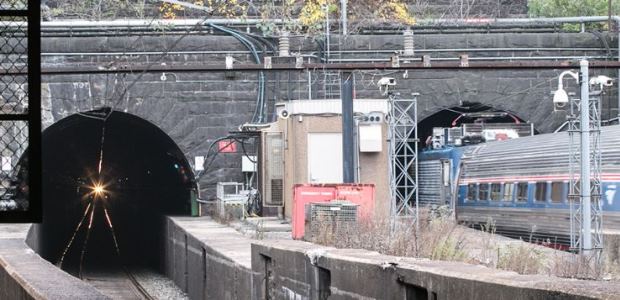
DOT Proposes $12.9 Billion Hudson Tunnel Plan
Building a new tunnel under the Hudson River is estimated to cost $11.1 billion and rehabilitating the existing tunnel would cost $1.8 billion more, according to DOT.
The Federal Railroad Administration published the Draft Environmental Impact Statement review for the Hudson Tunnel Project on July 6. Completed in 14 months, it identifies the project's preferred alternative -- a new tunnel under the Hudson River and refurbishing the existing North River Tunnel, in order to preserve the current functionality of the Amtrak Northeast Corridor's rail crossing between New Jersey and New York. Together, they are estimated to cost $12.9 billion. FRA said the final EIS is expected to be issued in March 2018.
NJ Transit also uses the North River Tunnel for commuter rail service.
Construction of two new rail tubes in a single tunnel beneath the Hudson River could maintain the existing level of train service while the North River Tunnel tubes are taken out of service, one at a time, for rehabilitation. "Once the North River Tunnel restoration is complete, both old and new tunnels will be in service, providing redundant capability and increased operational flexibility," according DOT.
Floodwaters from "Superstorm" Sandy damaged the existing 2.5-mile tunnel in October 2012, and it remains "compromised" and in poor condition but is safe for the trains that currently use it, according to the agency.
FRA will accept public comments on the Draft EIS until Aug. 21 and will host three public meetings on it: Aug. 1 in New York City; Aug. 3 in Secaucus, N.J.; and Aug.10 in Union City, N.J. Each hearing will include an afternoon session and an evening session.
The preferred alternative's alignment includes two new tracks extending from the Northeast Corridor in Secaucus through a tunnel beneath the Palisades and beneath the Hudson River. From there it connects to existing approach tracks that lead into New York's Penn Station.
The new tunnel would have a ventilation system designed to bring fresh air into the tunnel passively, through normal train movement, and also an active component driven by fans to remove hot air from the tunnel during congested conditions, when trains are stopped or moving slowly for extended periods, particularly during the summer. The active component would be used to control and exhaust hot air and smoke during emergency conditions, such as a fire on a train in the tunnel, and to move smoke so that smoke-free emergency routes are available for safe evacuation of passengers and firefighting operations. The fan plants' specific locations are still to be developed, but the DEIS shows them as a Hoboken fan plant, a Twelfth Avenue fan plant, and a Tenth Avenue fan plant.
Construction activities would begin in 2019 with construction of the new tunnel.